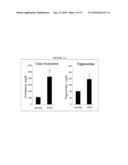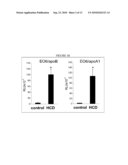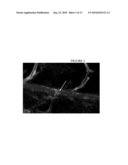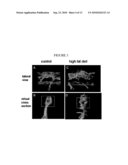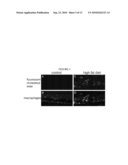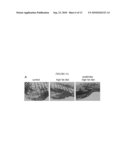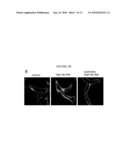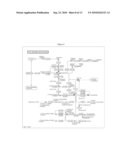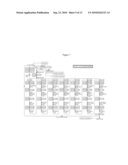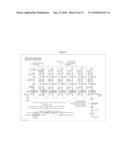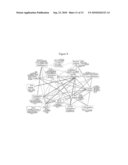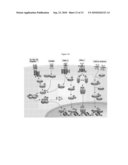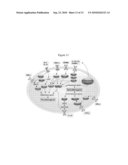Patent application title: MODELS OF ATHEROSCLEROSIS, HYPERLIPIDEMIA, LIPOPROTEIN OXIDATION AND BLOOD VESSEL INFLAMMATION AND METHODS FOR MAKING AND USING THEM
Inventors:
Yury Miller (San Diego, CA, US)
Konstantin Stoletov (San Diego, CA, US)
Richard Klemke (San Diego, CA, US)
Assignees:
THE REGENTS OF THE UNIVERSITY OF CALIFORNIA
IPC8 Class: AG01N3300FI
USPC Class:
800 3
Class name: Multicellular living organisms and unmodified parts thereof and related processes method of using a transgenic nonhuman animal in an in vivo test method (e.g., drug efficacy tests, etc.)
Publication date: 2010-09-23
Patent application number: 20100242123
Claims:
1. A genetically altered fish of the family Cyprinidae comprising or
consisting of:(i)(a) an exogenous gene or a set of genes related to lipid
metabolism; (b) at least one gene from a genetically (sequence) altered
ApoE, ApoAI and/or LDL-R gene locus, or a gene encoding polypeptide, or
gene, or protein, as illustrated in FIG. 6, FIG. 7, FIG. 8, FIG. 9, FIG.
10 and/or FIG. 11; (c) a deleted, or "knocked out" homologous gene or a
set of genes related to lipid metabolism; (d) the fish of (a) or (c),
wherein the gene or a set of genes related to lipid metabolism comprise
or consist of an ApoE, ApoAI and/or LDL-R gene; or (e) any combination of
(a) to (d);(ii) the genetically altered fish of claim (i), wherein the
fish is of the family Danio, or the fish is a zebrafish (Danio
rerio);(iii) the genetically altered fish of claim (i), wherein the ApoE,
ApoAI and/or LDL-R gene locus is completely or partially knocked
out);(iv) the genetically altered fish of claim (i), wherein at least one
nucleic acid residue of the ApoE, ApoAI and/or LDL-R gene locus is
altered or removed, or heterologous sequence is inserted into the ApoE,
ApoAI and/or LDL-R gene locus, or endogenous sequence is rearranged in
the ApoE, ApoAI and/or LDL-R gene locus);(v) the genetically altered fish
of claim (i), wherein the ApoE, ApoAI and/or LDL-R gene locus is modified
such that no or less amount of ApoE, ApoAI and/or LDL-R message
(transcript) and/or polypeptide is expressed); or(vi) the genetically
altered fish of claim (i), wherein the ApoE, ApoAI and/or LDL-R gene
locus is modified such that the ApoE, ApoAI and/or LDL-R polypeptides
have no or less activity.
2-3. (canceled)
4. An isolated or cultured cell or tissue derived from the fish of claim 1.
5-8. (canceled)
9. A method or model for studying the biology or pathology of, or for finding compounds capable of ameliorating or preventing or reversing: atherosclerosis; hyperlipidemia; lipoprotein oxidation; the accumulation of lipid in a blood vessel wall; vascular inflammation associated with lipid accumulation in a blood vessel wall; acute atherosclerosis-associated events; heart attack; stroke; or a combination thereof, comprising:(a) maintaining a fish of the family Cyprinidae under conditions comprising an altered diet and/or environmental conditions conducive to initiating or maintaining hyperlipidemia; lipoprotein oxidation; accumulation of lipid in a blood vessel wall of the fish, or conditions conducive to initiating or maintaining atherosclerosis;(b) the method of claim (a), wherein the altered diet comprises a high fat and/or cholesterol diet (an enriched fat and/or cholesterol diet);(c) the method of claim (b), wherein the fat or cholesterol comprises a fluorescently labeled lipid; or(d) the method of claim (a), wherein the fish is a genetically altered fish of claim 1.
10-12. (canceled)
13. A method for screening for a compound capable of ameliorating or preventing or reversing: atherosclerosis; hyperlipidemia; lipoprotein oxidation; the accumulation of lipid in a blood vessel wall; vascular inflammation associated with lipid accumulation in a blood vessel wall; acute atherosclerosis-associated events; heart attack; stroke, comprising:(i)(a) providing a test compound;(b) administering the test compound to (i) a genetically altered fish of claim 1; (ii) a fish of the family Cyprinidae under conditions comprising an altered diet and/or environmental conditions conducive to initiating or maintaining hyperlipidemia; lipoprotein oxidation; accumulation of lipid in a blood vessel wall of the fish, or conditions conducive to initiating or maintaining atherosclerosis; or (iii) the genetically altered fish of (i) under the diet and/or environmental conditions of (ii);(c) determining if the test compound ameliorates, prevents and/or reverses atherosclerosis and/or hyperlipidemia and/or lipoprotein oxidation and/or the accumulation of lipid in a blood vessel wall and/or vascular inflammation associated with lipid accumulation in a blood vessel wall;(ii) the method of (i), wherein the test compound is a small molecule, a polypeptide, a peptide, a nucleic acid, an siRNA, a polysaccharide or a lipid; or(iii) the method of (i), wherein the test compound is designed to target and/or increase or decrease the activity of: a matrix metalloproteinase, a lipoxygenase, a cyclooxygenase a phospholipase, a toll-like receptor, a NADPH oxidase, a nuclear receptor, a transcription factor NF-.kappa.B associated gene expression, macrophage lipid uptake, endothelial adhesion molecules and/or monocyte recruitment, smooth muscle cell growth and migration, apoptosis of vascular cells, phagocytosis of apoptotic cells, activation of T- and B-1 cells in the lesions, or a combination thereof.
14-15. (canceled)
Description:
TECHNICAL FIELD
[0001]This invention relates to molecular and cellular biology, biochemistry, molecular genetics, gene therapy, and drug design and discovery. In one aspect, the invention is directed to genetically altered fish of the family Cyprinidae, or genus Danio, including zebrafish (Danio rerio) and host cells and cell lines from these animals, where the fish have been genetically altered to lack or have a modified gene related to lipid metabolism, for example, an apolipoprotein E (ApoE), apolipoprotein A-I (ApoAI) and/or a low density lipoprotein receptor (LDL-R) gene. In another aspect, the invention is directed to drug design or discovery using the animal or cell models of the invention and/or wild type zebrafish, and by administering an altered diet and/or environment to the animal of invention.
BACKGROUND
[0002]Atherosclerosis is an inflammatory disease of blood vessels resulting in the growth of deposits of fatty substances, cholesterol, cellular waste products, calcium and other substances in the inner lining of an artery. This buildup is called plaque. It usually affects large and medium-sized arteries. Plaques can grow large enough to significantly reduce the blood flow through an artery. But most of the damage occurs when they become fragile and rupture. Plaques that rupture cause blood clots that can block blood flow or break off and travel to another part of the body. If either happens and blocks a blood vessel that feeds the heart, it causes a heart attack. If it blocks a blood vessel that feeds the brain, it causes a stroke.
[0003]Atherosclerosis starts when high content of cholesterol in the blood (hypercholesterolemia) leads to the lipid accumulation in the artery wall. This can start even in the fetus if the mother is hypercholesterolemic and progresses during the lifetime. Lipid accumulated in the artery wall undergoes oxidation and attracts inflammatory cells, monocytes, which differentiate into macrophages and take up the lipid. Resulting lipid-loaded macrophage "foam" cells residing in the artery inner layer (intima) are a hallmark of early atherosclerotic lesions. They further contribute to chronic vascular inflammation and the plaque growth. Therefore, studying the mechanisms of macrophage recruitment, lipid uptake and inflammation is important for understanding the pathogenesis of atherosclerosis. A feasible in vivo model of vascular lipid accumulation and inflammation will be also valuable for drug discovery.
[0004]Hyperlipidemia and hypercholesterolemia are developed as a consequence of an altered expression of genes regulating lipid metabolism and/or an altered dietary intake of lipids. In mammals, apolipoprotein E (ApoE), apolipoprotein A-I (ApoAI) and low density lipoprotein receptor (LDL-R) are critical proteins that regulate metabolism of lipoproteins, although many other genes are involved.
[0005]Current animal models of atherosclerosis: In an effort of establishing animal models of atherosclerosis researchers recreate in animals two major causative factors of the disease in humans, high cholesterol content in blood and high blood pressure. The latter is achieved by administration of high doses of angiotensin. However, the most popular models of atherosclerosis are the ones that achieve high levels of cholesterol in plasma. There are two animal species currently used to model atherosclerosis, hypercholesterolemic rabbits and genetically modified mice. Mouse models are especially widely utilized due to the availability of many transgenic and knockout strains.
[0006]Feeding atherosclerosis-susceptible mouse strains (C57BL6) high-fat, high-cholesterol diet causes the development of a very minimal atherosclerotic disease. However, this is greatly accelerated and increased in the mice deficient of either of two genes, which encode the proteins responsible for normal lipid delivery, the low-density lipoprotein receptor (LDLR) and apolipoprotein E (ApoE). The LDLR is on the surface of eventually every cell in the body; it recognizes LDL particles and, via the LDL uptake, the cells get nutrients, including fatty acids and cholesterol. ApoE is a part of lipoprotein particles and it also participates in the cellular uptake of lipid nutrients. The absence of either LDLR or ApoE, combined with the feeding a high-fat, high cholesterol diet, leads to the accumulation of high levels of LDL (the major carrier of cholesterol in blood) in plasma and eventually to its accumulation in artery wall and atherosclerosis.
[0007]Thus, LDLR.sup.-/- or ApoE.sup.-/- mice placed on high-fat diets are currently the two major animal models of atherosclerosis. Although having numerous advantages, these mouse models also have important limitations: A. Relatively long periods of pregnancy, maturation and cholesterol feeding, total from 6 to 12 months; B. A relatively high cost of maintaining of a mouse colony and numerous regulations for the handling of the mammals; C. A complex and labor intensive morphological analysis of atherosclerotic lesions; D. Atherosclerotic lesions in most cases can be analyzed only postmortem, e.g. at one time point only. Existing live animal imaging techniques are inadequate, of low resolution and often use radioactive materials.
SUMMARY
[0008]The invention provides stably genetically altered fish of the family Cyprinidae comprising at least one gene of lipid metabolism, such as genetically altered ApoE, ApoAI and/or LDL-R gene locus. The invention provides fish that have been genetically altered to lack or have a modified gene related to lipid metabolism; the genes can be e.g., an ApoE, ApoAI and/or LDL-R gene. In one aspect, the fish is of the family Danio, e.g., a zebrafish (Danio rerio). The invention provides isolated or cultured cells or tissues, or cell lines, derived from the fish of the invention. In one aspect, the gene or a set of genes related to lipid metabolism, e.g., the ApoE, ApoAI and/or LDL-R gene locus, are completely or partially knocked out in any combination; for example, in one aspect, only the ApoE, ApoAI and/or LDL-R are completely or partially knocked out, or alternatively some or all of these, or other lipid metabolism genes, are also completely or partially knocked out.
[0009]The invention provides stably genetically altered fish of the family Cyprinidae comprising or consisting of (a) an exogenous gene or a set of genes related to lipid metabolism, including the genes and/or polypeptides (or the sequence encoding them) illustrated or referenced in FIG. 6, FIG. 7, FIG. 8 and/or FIG. 9; (b) at least one gene from a genetically (sequence) altered ApoE, ApoAI and/or LDL-R gene locus; (c) a deleted, or "knocked out" homologous gene or a set of genes related to lipid metabolism; (d) the fish of (a) or (c), wherein the gene or a set of genes related to lipid metabolism comprise or consist of an ApoE, ApoAI and/or LDL-R gene; or (e) any combination of (a) to (d).
[0010]In one aspect, at least one nucleic acid residue of the gene or a set of genes related to lipid metabolism, e.g., ApoE, ApoAI and/or LDL-R gene locus, is altered or removed, or one or several heterologous sequences is/are inserted into the gene or a set of genes related to lipid metabolism, e.g., ApoE, ApoAI and/or LDL-R gene locus, or an endogenous sequence is rearranged in the gene or a set of genes related to lipid metabolism, e.g., ApoE, ApoAI and/or LDL-R gene locus. In one aspect, the gene or a set of genes related to lipid metabolism, e.g., ApoE, ApoAI and/or LDL-R gene locus is modified such that no or less amount of gene or a set of genes related to lipid metabolism, e.g., ApoE, ApoAI and/or LDL-R, message (transcript) and/or polypeptide is expressed. In one aspect, the gene or a set of genes related to lipid metabolism, e.g., ApoE, ApoAI and/or LDL-R gene locus, is modified such that the polypeptides, e.g., ApoE, ApoAI and/or LDL-R polypeptides, have no or less or altered activity.
[0011]The invention provides methods and/or models for studying the biology or pathology of lipoprotein metabolism and atherosclerosis or any inflammation associated with lipid accumulation, or for finding compounds capable of ameliorating or preventing or reversing: atherosclerosis; hyperlipidemia; lipoprotein oxidation; the accumulation of lipid in a blood vessel wall; vascular inflammation associated with lipid accumulation in a blood vessel wall; acute atherosclerosis-associated events; heart attack; stroke; or a combination thereof, comprising: maintaining a fish of the family Cyprinidae under conditions comprising an altered diet and/or environmental conditions conducive to initiating or maintaining accumulation of lipid in a blood vessel wall of the fish, or conditions conducive to initiating or maintaining atherosclerosis. In one aspect, the altered diet comprises a high fat diet (an enriched fat diet). In one aspect, the altered diet comprises a high cholesterol diet (an enriched cholesterol diet). In one aspect, the altered diet comprises a fluorescently labeled lipid. In one aspect, the fish is a wild type or a genetically altered fish of any one of the invention.
[0012]The invention provides methods for screening for a compound capable of ameliorating or preventing or reversing: atherosclerosis; hyperlipidemia; lipoprotein oxidation; the accumulation of lipid in a blood vessel wall; vascular inflammation associated with lipid accumulation in a blood vessel wall; acute atherosclerosis-associated events; heart attack; stroke, comprising: (a) providing a test compound; (b) administering the test compound to (i) a genetically altered fish of any one of the invention; (ii) a fish of the family Cyprinidae under conditions comprising an altered diet and/or environmental conditions conducive to initiating or maintaining hyperlipidemia, lipoprotein oxidation, accumulation of lipid in a blood vessel wall of the fish, or conditions conducive to initiating or maintaining atherosclerosis; or (iii) the genetically altered fish of (i) under the diet and/or environmental conditions of (ii); (c) determining if the test compound ameliorates, prevents and/or reverses atherosclerosis and/or the accumulation of lipid in a blood vessel wall and/or vascular inflammation associated with lipid accumulation in a blood vessel wall. In one aspect, the test compound is a small molecule, a polypeptide, a peptide, a nucleic acid, an siRNA, a polysaccharide or a lipid. In one aspect, the test compound is designed to target and/or increase or decrease the activity of: a matrix metalloproteinase, a lipoxygenase, a cyclooxygenase a phospholipase, a toll-like receptor, a NADPH oxidase, a nuclear receptor, a transcription factor NF-κB associated gene expression, macrophage lipid uptake, endothelial adhesion molecules and/or monocyte recruitment, smooth muscle cell growth and migration, apoptosis of vascular cells, phagocytosis of apoptotic cells, activation of T- and B-1 cells in the lesions, or a combination thereof.
[0013]Also provided herein are kits comprising cells of the invention including instructions for practicing the methods provided herein.
[0014]The details of one or more embodiments of the invention are set forth in the accompanying drawings and the description below. Other features, objects, and advantages of the invention will be apparent from the description and drawings, and from the claims.
[0015]All publications, patents, patent applications, GenBank sequences and ATCC deposits, cited herein are hereby expressly incorporated by reference for all purposes.
DESCRIPTION OF DRAWINGS
[0016]FIG. 1(A) illustrates data showing the total cholesterol (TC) and triglycerides (TG) in the plasma of a normal zebrafish and the zebrafish fed a high-cholesterol diet, as measured using automated enzymatic assays, as described in detail, below. FIG. 1(B) illustrates data from an immunoassay used to detect oxidized phospholipids in LDL and in HDL in the plasma of a normal zebrafish and the zebrafish fed a high-cholesterol diet, as described in detail, below.
[0017]FIG. 2 illustrates a confocal microscope image of cholesterol accumulation in the vasculature of a zebrafish, as described in detail, below.
[0018]FIG. 3 illustrates a confocal microscope image of disturbed endothelial cell morphology in the dorsal aorta of a zebrafish fed high-cholesterol diet, as described in detail, below; FIG. 3A and FIG. 3C are the images of dorsal aorta of a control and a high-cholesterol fed larva; FIG. 3B and FIG. 3D are the 3D images of the same aorta segments.
[0019]FIG. 4 illustrates a confocal microscope image of macrophage accumulation and cholesterol uptake in the dorsal aorta of a zebrafish larva, as described in detail, below.
[0020]FIG. 5(A) illustrates a microscope image showing that the addition of ezetimibe in the fish tank water considerably reduced a level of cholesterol accumulated in the digestive system of a zebrafish; the FIG. 5(B) illustrates images that demonstrate that ezetimibe prevented pathological changes in the endothelial layer morphology of the zebrafish, as inflicted by a high fat diet, as described in detail, below.
[0021]FIG. 6, FIG. 7 and FIG. 8 illustrate lipid-related metabolic pathways and their enzymes, including a glycerolipid metabolism pathway, a fatty acid biosynthesis pathway, and fatty acid metabolism, respectively, and set forth exemplary enzymes (including their fish homologues, or counterparts) that can be used to practice this invention.
[0022]FIG. 9 illustrates an atherosclerosis pathway interaction network, and shows a schematic representation of interactions between 16 biological and metabolic pathways that contain genes associated with atherosclerosis, and one or several of these polypeptide and/or genes, including their fish homologues (counterparts), can be used to practice this invention.
[0023]FIG. 10 illustrates signaling pathways involved in atherogenesis, and one or several of these polypeptide and/or genes, including their fish homologues (counterparts), can be used to practice this invention.
[0024]FIG. 11 illustrates genes and proteins, e.g., enzymes, involved in cross-talks between proinflammatory/proatherogenic and anti-inflammatory/antiatherogenic signal transduction pathways, and one or several of these polypeptide and/or genes, including their fish homologues (counterparts), can be used to practice this invention
[0025]Like reference symbols in the various drawings indicate like elements.
DETAILED DESCRIPTION
[0026]The invention provides a novel fish (e.g., zebrafish) model to study mechanisms of and finding therapies against hyperlipidemia, lipoprotein oxidation, accumulation of lipid in the blood vessel wall and associated inflammation, including vascular inflammation. These processes can be rate-limiting steps in the formation of atherosclerotic lesions in humans and further promote the advanced lesion development, which may eventually result in heart attack or ischemic stroke, the two major causes of mortality in developed countries. Thus, the invention provides a model to study mechanisms of and finding therapies against (e.g., compositions and methods for the amelioration of) atherosclerotic lesions in humans, heart attack or ischemic stroke, hyperlipidemia, lipoprotein oxidation, accumulation of lipid in the blood vessel wall and associated inflammation, including vascular inflammation.
[0027]In one aspect, the invention provides stable genetically altered fish of the family Cyprinidae comprising or consisting of (a) an exogenous gene or a set of genes related to lipid metabolism, e.g., as set forth in FIG. 6, FIG. 7, FIG. 8, FIG. 9, FIG. 10 and/or FIG. 11; (b) at least one gene from a genetically (sequence) altered ApoE, ApoAI and/or LDL-R gene locus; (c) a deleted, or "knocked out" homologous gene or a set of genes related to lipid metabolism; (d) the fish of (a) or (c), wherein the gene or a set of genes related to lipid metabolism comprise or consist of an ApoE, ApoAI and/or LDL-R gene; or (e) any combination of (a) to (d). FIG. 9 illustrates an atherosclerosis pathway interaction network, and shows a schematic representation of interactions between sixteen biological and metabolic pathways that contain genes associated with atherosclerosis, and one or several of these genes, including their fish homologues (counterparts), can be used to practice this invention. The connections between the pathways illustrate the presence of common atherosclerosis genes in two pathways. IL-10, interleukin-10; LDLR, LDL receptor; PPARα, peroxisome proliferator-activated receptor α; Th1/Th2, T helper cell 1/2; TLR, toll-like receptor; TNF-α, tumor necrosis factor-α; genes encoding these proteins, including their fish homologues (counterparts), also can be used to practice this invention.
[0028]FIG. 10 illustrates signaling pathways involved in atherogenesis, and one or several of these polypeptide and/or genes, including their fish homologues (counterparts), can be used to practice this invention; for example, genes encoding the following can be manipulated in the genetically altered fish of this invention: proinflammatory cytokines (IL-1, IL-18) and pathogens (represented as pathogen-associated molecular patterns, PAMP), as well as nonpathogen activators of TLR, act through distinct signaling pathways that converge on the activation of NF-κB; MyD88 functions as an adaptor between receptors of the TLR or IL-1R families and downstream signaling kinases; following association of MyD88 with IL-1-associated kinase IRAK-4, IRAK-4 is autophosphorylated, dissociates from the receptor complex, and interacts with TNF-receptor-associated factor-6 (TRAF-6), which also mediates CD40 signaling; once activated, TRAF6 associates with the MAP3 kinase TAK1 (716); from TAK1, two signaling pathways diverge; one ultimately leads to NF-κB activation and the other to MAP kinase activation; in its inactive form, NF-κB is bound to inhibitor of κB (IK-κBα/β) in the cytoplasm and consists of an LB kinase (IKK) complex containing two kinases IKKα and IKKβ, and the regulatory protein IKKγ (also named NEMO); IKK activation initiates IκBα/β phosphorylation; phosphorylated LB is then ubiquitinated, leading to its degradation by the 26S proteasome; this releases NF-κB dimers from the cytoplasmic NF-κB-IκB complex, allowing them to translocate to the nucleus. JNK phosphorylation is mediated by two MAPK kinases (MAPKKs), MKK4 and MKK7, that they can cooperatively activate JNK. Both kinases are required for full activation of JNK by environmental stressors, and MKK7 is essential for JNK activation by TNR engagement. Tyrosine phosphorylation activates the cytosolic inactive STATs, resulting in their nuclear translocation and gene activation. This pathway was originally found to be activated by IFNs, but a number of cytokines, growth factors, and hormonal factors also activate JAK and/or STAT proteins. IFN-γ utilizes JAK1 and JAK2, and usually activates STAT1. TGF-β-triggered signals are transduced by proteins belonging to the Smad (for vertebrate homologs of Sma and Mad) family. The type I receptor recognizes and phosphorylates Smad2 and Smad3, which associates with Smad4, forming complexes that participate in DNA binding and recruitment of transcription factors. Smad3 may also have antagonistic properties, as it plays a critical role in TGF-β-dependent repression of vascular inflammation by inhibiting AP-1 activity. Smad7 inhibits Smad2 and Smad3 phosphorylation. See, e.g., Tedgui et al., Physiol. Rev. 86: 515-581, 2006.
[0029]FIG. 11 illustrates genes and proteins, e.g., enzymes, involved in cross-talks between proinflammatory/pro-atherogenic and anti-inflammatory/antiatherogenic signal transduction pathways, and one or several of these polypeptide and/or genes, including their fish homologues (counterparts), can be used to practice this invention; for example, genes encoding the following can be manipulated in the genetically altered fish of this invention: inhibitory Smads such as Smad7 downstream of IFN-γ signaling associate with activated receptors and interfere with Smad2 and Smad3 binding; IFN-γ, the anti-inflammatory cytokine IL-10 also activates JAK and/or STAT proteins; IL-10/IL-10R interaction activates JAK1 and Tyk2, leading to STAT3 and SOCS3 activation, which is central for the anti-inflammatory responses of IL-10 in macrophages; an inflammasome may be a central link between apoptosis and inflammation in pathological conditions; NF-κB may have a dual role in atherosclerosis, being pro-atherogenic through its proinflammatory properties, and antiatherogenic through its anti-apoptotic activities. See, e.g., Tedgui et al., Physiol. Rev. 86: 515-581, 2006.
[0030]In one aspect, a zebrafish model of atherosclerosis is generated by altering dietary and environmental conditions and/or a genetic background of zebrafish. Examples of such alterations are high cholesterol diet and ApoE knockdown:
[0031]1. Feeding zebrafish with a diet enriched with cholesterol leads to lipid accumulation in blood vessels and atherosclerosis. Addition of a fluorescently labeled lipid facilitates visualizing the lipid accumulation in blood vessels.
[0032]2. Knockdown of ApoE, combined with high-cholesterol diet, accelerates and/or increases atherosclerosis burden in zebrafish.
[0033]3. Development of vascular inflammation and atherosclerosis is observed in an optically transparent zebrafish with fluorescent vasculature (fli:EGFP) and in real time using a fluorescent microscope.
[0034]In one aspect, the methods of the invention are practiced using optical transparence. Optical transparence of zebrafish makes it a unique model for a real-time, multiparametic in vivo study of the processes involved in atherosclerosis. In addition, the models of this invention make screening of drug candidates for atherosclerosis therapy feasible and cost effective.
[0035]The fish and cells of the invention, e.g., zebrafish, provide models for various developmental, physiological and pathological processes. The use of fish and cells of the invention are optimal for the development of a model of atherosclerosis for the following reasons:
[0036]A. A zebrafish embryo/larva is optically transparent for up to 30 days, which allows conducting real time microscopic observations in a live animal. Zebrafish can be easily genetically modified. For example, in a transgenic zebrafish strain with enhanced green fluorescence protein (EGFP) constitutively expressed in endothelial cells (the cells that cover the inner surface of blood vessels), fli:EGFP, vascular system is readily visualized under a fluorescent microscope.
[0037]B. A zebrafish colony maintenance is by far more economic than the maintenance of a mouse colony.
[0038]C. New drug candidates can be easily tested in a zebrafish model by simply adding them to the water in a fish tank. This makes zebrafish an ultimate in vivo model for new drug development.
[0039]D. Zebrafish embryo feeds from yolk for the first 5 days post fertilization and is free feeding thereafter. The yolk sac constantly forms lipoproteins, which then gain entry into circulation and supply nutrients to the tissues. Remarkably, zebrafish ApoE, which is homologous to human and mouse ApoE, is highly expressed in the yolk sac. This suggests that the mechanisms of lipoprotein delivery are similar in zebrafish and in mammals, and regulated manipulation with these processes gains a suitable model for atherosclerosis, a disease originating from disturbed lipid metabolism.
[0040]Thus, this invention provides applications of finding therapeutic targets and pre-clinical testing of the therapies to prevent and/or slow down the development of atherosclerosis. The potential targets may include but not limited to: [0041]macrophage matrix metalloproteinases, [0042]12/15-lipoxygenase, [0043]5-lipoxygenase, [0044]toll-like receptors 2 and 4, [0045]NF-kappaB associated gene expression, [0046]macrophage lipid uptake, [0047]endothelial adhesion molecules and monocyte recruitment, [0048]smooth muscle cell growth and migration, [0049]apoptosis of vascular cells, [0050]phagocytosis of apoptotic cells, [0051]activation of T- and B-1 cells in the lesions, and many others.
[0052]Feasibility and low cost of the zebrafish model, together with its access to real-time imaging of atherosclerotic processes in a live animal, make it an attractive object for commercial applications.
[0053]In another aspect of the invention, a nucleic acid used to practice the invention, including any gene or genes related to lipid metabolism e.g., a ApoE, ApoAI and/or LDL-R gene locus, an expression vector used to insert or express any gene or genes related to lipid metabolism, such as a ApoE, ApoAI and/or LDL-R gene locus, in a cell, cell line, or a fish of the invention, or any target sequence, can comprise a reporter or a marker gene (including nucleic acid sequences that encode proteins that can be used for reporting activity, e.g., enzymes or epitopes). In one aspect, the reporter or marker gene is used to monitor gene (e.g., an ApoE, ApoAI and/or LDL-R gene locus) expression, e.g., one, several or all coding sequence in the locus can be marked with the same or different markers. In one aspect, the reporter or marker gene is used to monitor gene suppression or silencing. In one aspect of the invention, the reporter gene comprises green fluorescent protein. Any compound, fluorophore, label, isotope, protein or gene that has a reporting or marking function can be used in the methods provided herein.
[0054]In another aspect of the invention, nucleic acids used to practice the invention, including any gene or genes related to lipid metabolism, e.g., ApoE, ApoAI and/or LDL-R gene locus, an expression vector, or any target sequences are inserted into the genome of a host cell by e.g. a vector, a virus or any nucleic acid shuttling or insertional mechanism. For example, a nucleic acid sequence can be inserted into a genome or a vector by a variety of procedures. In one aspect, the sequence is ligated to the desired position in the vector following digestion of the insert and the vector with appropriate restriction endonucleases. Alternatively, blunt ends in both the insert and the vector may be ligated. In one aspect, viral long terminal repeats (LTRs) are inserted in a flanking pattern to effect insertion of a desired sequence (e.g., ApoE, ApoAI and/or LDL-R and/or another gene locus) into a genome. In one aspect, sequences homologous to a genome target sequence (targeting where in the genome it is desired to insert a desired nucleic acid, e.g., ApoE, ApoAI and/or LDL-R and/or another gene locus) are inserted in a flanking pattern to effect insertion of the desired sequence into a genome. A variety of cloning techniques are known in the art, e.g., as described in Ausubel and Sambrook. Such procedures and others are deemed to be within the scope of those skilled in the art.
[0055]The vector used to make or practice the invention can be chosen from any number of suitable vectors known to those skilled in the art, including cosmids, YACs (Yeast Artificial Chromosomes), megaYACS, BACs (Bacterial Artificial Chromosomes), PACs (P1 Artificial Chromosome), MACs (Mammalian Artificial Chromosomes), a whole chromosome, or a small whole genome. The vector also can be in the form of a plasmid, a viral particle, or a phage. Other vectors include chromosomal, non-chromosomal and synthetic DNA sequences, derivatives of SV40; bacterial plasmids, phage DNA, baculovirus, yeast plasmids, vectors derived from combinations of plasmids and phage DNA, viral DNA such as vaccinia, adenovirus, fowl pox virus, and pseudorabies. A variety of cloning and expression vectors for use with prokaryotic and eukaryotic hosts are described by, e.g., Sambrook. Particular bacterial vectors which can be used include the commercially available plasmids comprising genetic elements of the well known cloning vector pBR322 (ATCC 37017), pKK223-3 (Pharmacia Fine Chemicals, Uppsala, Sweden), GEM1 (Promega Biotec, Madison, Wis., USA) pQE70, pQE60, pQE-9 (Qiagen), pD10, psiX174 pBluescript II KS, pNH8A, pNH16a, pNH18A, pNH46A (Stratagene), ptrc99a, pKK223-3, pKK233-3, DR540, pRIT5 (Pharmacia), pKK232-8 and pCM7. Particular eukaryotic vectors include pSV2CAT, pOG44, pXT1, pSG (Stratagene) pSVK3, pBPV, pMSG, and pSVL (Pharmacia). However, any other vector may be used as long as it is replicable and viable in the host cell. In one aspect of the invention, target sequences are integrated into genomes using a lentiviral feline immunodeficiency (FIV) vector for the transduction process.
[0056]The invention provides a fish comprising deleted or modified gene or genes related to lipid metabolism, e.g., ApoE, ApoAI and/or LDL-R) gene loci. In some aspects, the (fish) endogenous gene or genes related to lipid metabolism, e.g., ApoE, ApoAI and/or LDL-R gene locus, has been completely, or partially, disabled ("knocked out"). Nucleic acids used to practice the invention, including any gene or genes related to lipid metabolism, e.g., the fish ApoE, ApoAI and/or LDL-R gene locus, and vectors comprising this or other nucleic acids (e.g., including other ApoE, ApoAI and/or LDL-R gene loci segments for making "knockout" animals) can be made, isolated and/or manipulated by, e.g., cloning and expression of cDNA libraries, amplification of message or genomic DNA by PCR, and the like. In practicing the methods of the invention, homologous or exogenous genes (e.g., gene or genes related to lipid metabolism, e.g., such as ApoE, ApoAI and/or LDL-R loci genes) can be modified by manipulating a template nucleic acid, as described herein. The invention can be practiced in conjunction with any method or protocol or device known in the art, which are well described in the scientific and patent literature.
[0057]A fish of the invention include both animals having stably inserted exogenous or homologous gene or genes related to lipid metabolism, e.g., ApoE, ApoAI and/or LDL-R sequences (e.g., a complete or partial ApoE, ApoAI and/or LDL-R gene locus), unstable genomic inserts, mitochondrial inserts, or episomal inserts, e.g., as artificial chromosomes that are episomal to the endogenous chromosomes of the animal.
[0058]The nucleic acids used to practice this invention, whether RNA, iRNA, siRNA, antisense nucleic acid, cDNA, genomic DNA, vectors, viruses or hybrids thereof, may be isolated from a variety of sources, genetically engineered, amplified, and/or expressed/generated recombinantly. Recombinant polypeptides generated from these nucleic acids can be individually isolated or cloned and tested for a desired activity. Any recombinant expression system can be used, including bacterial, mammalian, yeast, insect or plant cell expression systems.
[0059]Alternatively, these nucleic acids can be synthesized in vitro by well-known chemical synthesis techniques, as described in, e.g., Adams (1983) J. Am. Chem. Soc. 105:661; Belousov (1997) Nucleic Acids Res. 25:3440-3444; Frenkel (1995) Free Radic. Biol. Med. 19:373-380; Blommers (1994) Biochemistry 33:7886-7896; Narang (1979) Meth. Enzymol. 68:90; Brown (1979) Meth. Enzymol. 68:109; Beaucage (1981) Tetra. Lett. 22:1859; U.S. Pat. No. 4,458,066. Alternatively, nucleic acids can be obtained from commercial sources.
[0060]Techniques for the manipulation of nucleic acids, such as, e.g., subcloning, labeling probes (e.g., random-primer labeling using Klenow polymerase, nick translation, amplification), sequencing, hybridization and the like are well described in the scientific and patent literature, see, e.g., Sambrook, ed., Molecular Cloning: A Laboratory Manual (2nd ed.), Vols. 1-3, Cold Spring Harbor Laboratory, (1989); Current Protocols in Molecular Biology, Ausubel, ed. John Wiley & Sons, Inc., New York (1997); Laboratory Techniques in Biochemistry and Molecular Biology: Hybridization with Nucleic Acid Probes, Part I. Theory and Nucleic Acid Preparation, Tijssen, ed. Elsevier, N.Y. (1993).
[0061]Another useful means of obtaining and manipulating nucleic acids used to practice the methods of the invention is to clone from genomic samples, and, if desired, screen and re-clone inserts isolated or amplified from, e.g., genomic clones or cDNA clones. Sources of nucleic acid used in the methods of the invention include genomic or cDNA libraries contained in, e.g., mammalian artificial chromosomes (MACs), see, e.g., U.S. Pat. Nos. 5,721,118; 6,025,155; human artificial chromosomes, see, e.g., Rosenfeld (1997) Nat. Genet. 15:333-335; yeast artificial chromosomes (YAC); bacterial artificial chromosomes (BAC); P1 artificial chromosomes, see, e.g., Woon (1998) Genomics 50:306-316; P1-derived vectors (PACs), see, e.g., Kern (1997) Biotechniques 23:120-124; cosmids, recombinant viruses, phages or plasmids.
[0062]In practicing the invention, nucleic acids of the invention or modified nucleic acids of the invention, can be reproduced by amplification. Amplification can also be used to clone or modify the nucleic acids of the invention. Thus, the invention provides amplification primer sequence pairs for amplifying nucleic acids of the invention. One of skill in the art can design amplification primer sequence pairs for any part of or the full length of these sequences.
[0063]Amplification reactions can also be used to quantify the amount of nucleic acid in a sample (such as the amount of message in a cell sample), label the nucleic acid (e.g., to apply it to an array or a blot), detect the nucleic acid, or quantify the amount of a specific nucleic acid in a sample. In one aspect of the invention, message isolated from a cell or a cDNA library are amplified.
[0064]The skilled artisan can select and design suitable oligonucleotide amplification primers. Amplification methods are also well known in the art, and include, e.g., polymerase chain reaction, PCR (see, e.g., PCR Protocols, A Guide to Methods and Applications, ed. Innis, Academic Press, N.Y. (1990) and PCR Strategies (1995), ed. Innis, Academic Press, Inc., N.Y., ligase chain reaction (LCR) (see, e.g., Wu (1989) Genomics 4:560; Landegren (1988) Science 241:1077; Barringer (1990) Gene 89:117); transcription amplification (see, e.g., Kwoh (1989) Proc. Natl. Acad. Sci. USA 86:1173); and, self-sustained sequence replication (see, e.g., Guatelli (1990) Proc. Natl. Acad. Sci. USA 87:1874); Q Beta replicase amplification (see, e.g., Smith (1997) J. Clin. Microbiol. 35:1477-1491), automated Q-beta replicase amplification assay (see, e.g., Burg (1996) Mol. Cell. Probes 10:257-271) and other RNA polymerase mediated techniques (e.g., NASBA, Cangene, Mississauga, Ontario); see also Berger (1987) Methods Enzymol. 152:307-316; Sambrook; Ausubel; U.S. Pat. Nos. 4,683,195 and 4,683,202; and Sooknanan (1995) Biotechnology 13:563-564.
[0065]The sequences of the nucleic acids, e.g., the genes or messages (mRNA), related to lipid metabolism, for example, an ApoE, ApoAI and/or LDL-R gene or message, used to practice this invention are well known in the art; for example: [0066]In one aspect, human (Homo sapiens) apolipoprotein E (ApoE) sequences can be used (either from complete or partial genomic (gene) or mRNA, or message, sequence) to practice this invention, e.g., in one aspect, human ApoE sequence is inserted into an animal model or cell or cell line of this invention as an exogenous sequences; e.g., in one aspect, all or part of the message for human ApoE is used:
TABLE-US-00001 [0066](SEQ ID NO: 1) 1 gggatccttg agtcctactc agccccagcg gaggtgaagg acgtccttcc ccaggagccg 61 actggccaat cacaggcagg aagatgaagg ttctgtgggc tgcgttgctg gtcacattcc 121 tggcaggatg ccaggccaag gtggagcaag cggtggagac agagccggag cccgagctgc 181 gccagcagac cgagtggcag agcggccagc gctgggaact ggcactgggt cgcttttggg 241 attacctgcg ctgggtgcag acactgtctg agcaggtgca ggaggagctg ctcagctccc 301 aggtcaccca ggaactgagg gcgctgatgg acgagaccat gaaggagttg aaggcctaca 361 aatcggaact ggaggaacaa ctgaccccgg tggcggagga gacgcgggca cggctgtcca 421 aggagctgca ggcggcgcag gcccggctgg gcgcggacat ggaggacgtg tgcggccgcc 481 tggtgcagta ccgcggcgag gtgcaggcca tgctcggcca gagcaccgag gagctgcggg 541 tgcgcctcgc ctcccacctg cgcaagctgc gtaagcggct cctccgcgat gccgatgacc 601 tgcagaagcg cctggcagtg taccaggccg gggcccgcga gggcgccgag cgcggcctca 661 gcgccatccg cgagcgcctg gggcccctgg tggaacaggg ccgcgtgcgg gccgccactg 721 tgggctccct ggccggccag ccgctacagg agcgggccca ggcctggggc gagcggctgc 781 gcgcgcggat ggaggagatg ggcagccgga cccgcgaccg cctggacgag gtgaaggagc 841 aggtggcgga ggtgcgcgcc aagctggagg agcaggccca gcagatacgc ctgcaggccg 901 aggccttcca ggcccgcctc aagagctggt tcgagcccct ggtggaagac atgcagcgcc 961 agtgggccgg gctggtggag aaggtgcagg ctgccgtggg caccagcgcc gcccctgtgc 1021 ccagcgacaa tcactgaacg ccgaagcctg cagccatgcg accccacgcc accccgtgcc 1081 tcctgcctcc gcgcagcctg cagcgggaga ccctgtcccc gccccagccg tcctcctggg 1141 gtggacccta gtttaataaa gattcaccaa gtttcacgca aaaaaaaaaa aaaaaaaaaa 1201 aaaaaaaaaa aaaaaaaaaa aaa
[0067]Alternatively, all or part of a sequence encoding human ApoE is used, e.g., the human ApoE amino acid sequence can be:
TABLE-US-00002 (SEQ ID NO: 2) MKVLWAALLVTFLAGCQAKVEQAVETEPEPELRQQTEWQSGQRWELALGR FWDYLRWVQTLSEQVQEELLSSQVTQELRALMDETMKELKAYKSELEEQL TPVAEETRARLSKELQAAQARLGADMEDVCGRLVQYRGEVQAMLGQSTEE LRVRLASHLRKLRKRLLRDADDLQKRLAVYQAGAREGAERGLSAIRERLG PLVEQGRVRAATVGSLAGQPLQERAQAWGERLRARMEEMGSRTRDRLDEV KEQVAEVRAKLEEQAQQIRLQAEAFQARLKSWFEPLVEDMQRQWAGLVEK VQAAVGTSAAPVPSDNH
[0068]In one alternative aspect, Danio rerio (zebrafish) apolipoprotein E (ApoE) sequences are used (either from complete or partial genomic (gene) or mRNA, or message, sequence) to practice this invention, e.g., in one aspect, zebrafish ApoE sequence is modified, knocked out, or modified and re-inserted into an animal model or cell or cell line of this invention as an altered (modified, mutated) endogenous sequence (including deletions, additions, base substitutions), or as an exogenous sequence; e.g., in one aspect, all or part of the message for zebrafish ApoE is used:
TABLE-US-00003 [0068](SEQ ID NO: 3) 1 atcaacatga ggtctcttgt ggtattcttt gccctggcag ttttaactgg ctgccaggct 61 cgtagcctgt tccaggctga tgcccctcag cccagatggg aggagatggt ggaccgtttc 121 tggcagtatg tgtctgaact caacacacaa actgacggca tggtgcaaaa catcaagggc 181 tcccagctca gcagagagct tgacacacta attactgaca ccatggctga actgagctca 241 tacagtgaaa atctccaaac ccagatgacc ccatatgcct ctgatgctgc tggtcagctc 301 agtaaagatc ttcagctcct ggctggaaaa ctccaaactg acatgaccga cgctaaggaa 361 cgcagcactc agtacctgca agagctgaag accatgatgg agcaaaatgc agatgacgtg 421 aagaaccgtg tcggcaccta cacacgcaaa ctgaagaaac gcctgaacaa ggacacagag 481 gagatccgca acaccgtagc aacctacatg agtgagatgc agtcccgcgc ttcccaaaat 541 gctgatgcag tgaaggaccg tttccagcca tacatgagcc aggcccagga tggcgccacc 601 cagaaactgg gcgccattag cgagctgatg aaggcccagg cgcaggaggt gagcgagcag 661 ttggaggtcc aggctggagc tctgaaggag aagctggagg agacagccga gaacctacgc 721 acctctctgg agggccgtgt ggatgagctg accagcctcc tcgcccccta ctcccagaag 781 atccgcgagc agctgcagga agtcatggac aagatcaagg aggccacagc agctcttccc 841 actcaggctt aagagctcca cacttaccta gtgttaacac caaacagaaa gaagaaggga 901 ggctttgtgt tactgaaatg tgcttttttc attctgtgag aggttgataa agtggttaac 961 aactggactc aattggacta gcactgtcct ttactggaca aaagaaatgc catgttactc 1021 accacgttta ctttctcagt attaacccat gtctgaggat atatttctgt tagcgtacag 1081 tagagcgaat ttaagatcaa tcaacttgtc tgtcttggag gctatttttt ctagttagtg 1141 gggccaaact tggcgtcatt caaaataaat agtaatcaaa aggtgccttc agctgctgaa 1201 atgaatcaga acacatgaaa gatgagcttt gttagtcaac agtccacata taaatgcttg 1261 tttactttac atgtttgtgc actgatgtgt ttgaatttgt ttgcaataaa tgtgcgttct 1321 actacacaaa aaaaaaaaaa aaaaa
[0069]In one aspect, all or part of a sequence encoding zebrafish ApoE is used, e.g., the zebrafish ApoE amino acid sequence can be:
TABLE-US-00004 (SEQ ID NO: 4) MRSLVVFFALAVLTGCQARSLFQADAPQPRWEEMVDRFWQYVSELNTQTD GMVQNIKGSQLSRELDTLITDTMAELSSYSENLQTQMTPYASDAAGQLSK DLQLLAGKLQTDMTDAKERSTQYLQELKTMMEQNADDVKNRVGTYTRKLK KRLNKDTEEIRNTVATYMSEMQSRASQNADAVKDRFQPYMSQAQDGATQK LGAISELMKAQAQEVSEQLEVQAGALKEKLEETAENLRTSLEGRVDELTS LLAPYSQKIREQLQEVMDKIKEATAALPTQA
[0070]In one aspect, human (Homo sapiens) apolipoprotein A-I (ApoAI) sequences can be used (either from complete or partial genomic (gene) or mRNA, or message, sequence) to practice this invention, e.g., in one aspect, human ApoAI sequence is inserted into an animal model or cell or cell line of this invention as an exogenous sequences; e.g., in one aspect, all or part of the message for human ApoAI is used:
TABLE-US-00005 [0070](SEQ ID NO: 5) 1 agagactgcg agaaggaggt cccccacggc ccttcaggat gaaagctgcg gtgctgacct 61 tggccgtgct cttcctgacg gggagccagg ctcggcattt ctggcagcaa gatgaacccc 121 cccagagccc ctgggatcga gtgaaggacc tggccactgt gtacgtggat gtgctcaaag 181 acagcggcag agactatgtg tcccagtttg aaggctccgc cttgggaaaa cagctaaacc 241 taaagctcct tgacaactgg gacagcgtga cctccacctt cagcaagctg cgcgaacagc 301 tcggccctgt gacccaggag ttctgggata acctggaaaa ggagacagag ggcctgaggc 361 aggagatgag caaggatctg gaggaggtga aggccaaggt gcagccctac ctggacgact 421 tccagaagaa gtggcaggag gagatggagc tctaccgcca gaaggtggag ccgctgcgcg 481 cagagctcca agagggcgcg cgccagaagc tgcacgagct gcaagagaag ctgagcccac 541 tgggcgagga gatgcgcgac cgcgcgcgcg cccatgtgga cgcgctgcgc acgcatctgg 601 ccccctacag cgacgagctg cgccagcgct tggccgcgcg ccttgaggct ctcaaggaga 661 acggcggcgc cagactggcc gagtaccacg ccaaggccac cgagcatctg agcacgctca 721 gcgagaaggc caagcccgcg ctcgaggacc tccgccaagg cctgctgccc gtgctggaga 781 gcttcaaggt cagcttcctg agcgctctcg aggagtacac taagaagctc aacacccagt 841 gaggcgcccg ccgccgcccc ccttcccggt gctcagaata aacgtttcca aagtggg
[0071]In one aspect, all or part of a sequence encoding human ApoAI is used, e.g., the human ApoAI amino acid sequence can be:
TABLE-US-00006 (SEQ ID NO: 6) MKAAVLTLAVLFLTGSQARHFWQQDEPPQSPWDRVKDLATVYVDVLKDSG RDYVSQFEGSALGKQLNLKLLDNWDSVTSTFSKLREQLGPVTQEFWDNLE KETEGLRQEMSKDLEEVKAKVQPYLDDFQKKWQEEMELYRQKVEPLRAEL QEGARQKLHELQEKLSPLGEEMRDRARAHVDALRTHLAPYSDELRQRLAA RLEALKENGGARLAEYHAKATEHLSTLSEKAKPALEDLRQGLLPVLESFK VSFLSALEEYTKKLNTQ
[0072]In one aspect, human (Homo sapiens) LDL-R sequences can be used (either from complete or partial genomic (gene) or mRNA, or message, sequence) to practice this invention, e.g., in one aspect, human LDL-R sequence is inserted into an animal model or cell or cell line of this invention as an exogenous sequences; e.g., in one aspect, all or part of the message for human LDL-R is used:
TABLE-US-00007 [0072](SEQ ID NO: 7) 1 cagaggctgc gagcatgggg ccctggggct ggaaattgcg ctggaccgtc gccttgctcc 61 tcgccgcggc ggggactgca gtgggcgaca gatgcgaaag aaacgagttc cagtgccaag 121 acgggaaatg catctcctac aagtgggtct gcgatggcag cgctgagtgc caggatggct 181 ctgatgagtc ccaggagacg tgcttgtctg tcacctgcaa atccggggac ttcagctgtg 241 ggggccgtgt caaccgctgc attcctcagt tctggaggtg cgatggccaa gtggactgcg 301 acaacggctc agacgagcaa ggctgtcccc ccaagacgtg ctcccaggac gagtttcgct 361 gccacgatgg gaagtgcatc tctcggcagt tcgtctgtga ctcagaccgg gactgcttgg 421 acggctcaga cgaggcctcc tgcccggtgc tcacctgtgg tcccgccagc ttccagtgca 481 acagctccac ctgcatcccc cagctgtggg cctgcgacaa cgaccccgac tgcgaagatg 541 gctcggatga gtggccgcag cgctgtaggg gtctttacgt gttccaaggg gacagtagcc 601 cctgctcggc cttcgagttc cactgcctaa gtggcgagtg catccactcc agctggcgct 661 gtgatggtgg ccccgactgc aaggacaaat ctgacgagga aaactgcgct gtggccacct 721 gtcgccctga cgaattccag tgctctgatg gaaactgcat ccatggcagc cggcagtgtg 781 accgggaata tgactgcaag gacatgagcg atgaagttgg ctgcgttaat gtgacactct 841 gcgagggacc caacaagttc aagtgtcaca gcggcgaatg catcaccctg gacaaagtct 901 gcaacatggc tagagactgc cgggactggt cagatgaacc catcaaagag tgcgggacca 961 acgaatgctt ggacaacaac ggcggctgtt cccacgtctg caatgacctt aagatcggct 1021 acgagtgcct gtgccccgac ggcttccagc tggtggccca gcgaagatgc gaagatatcg 1081 atgagtgtca ggatcccgac acctgcagcc agctctgcgt gaacctggag ggtggctaca 1141 agtgccagtg tgaggaaggc ttccagctgg acccccacac gaaggcctgc aaggctgtgg 1201 gctccatcgc ctacctcttc ttcaccaacc ggcacgaggt caggaagatg acgctggacc 1261 ggagcgagta caccagcctc atccccaacc tgaggaacgt ggtcgctctg gacacggagg 1321 tggccagcaa tagaatctac tggtctgacc tgtcccagag aatgatctgc agcacccagc 1381 ttgacagagc ccacggcgtc tcttcctatg acaccgtcat cagcagggac atccaggccc 1441 ccgacgggct ggctgtggac tggatccaca gcaacatcta ctggaccgac tctgtcctgg 1501 gcactgtctc tgttgcggat accaagggcg tgaagaggaa aacgttattc agggagaacg 1561 gctccaagcc aagggccatc gtggtggatc ctgttcatgg cttcatgtac tggactgact 1621 ggggaactcc cgccaagatc aagaaagggg gcctgaatgg tgtggacatc tactcgctgg 1681 tgactgaaaa cattcagtgg cccaatggca tcaccctaga tctcctcagt ggccgcctct 1741 actgggttga ctccaaactt cactccatct caagcatcga tgtcaacggg ggcaaccgga 1801 agaccatctt ggaggatgaa aagaggctgg cccacccctt ctccttggcc gtctttgagg 1861 acaaagtatt ttggacagat atcatcaacg aagccatttt cagtgccaac cgcctcacag 1921 gttccgatgt caacttgttg gctgaaaacc tactgtcccc agaggatatg gttctcttcc 1981 acaacctcac ccagccaaga ggagtgaact ggtgtgagag gaccaccctg agcaatggcg 2041 gctgccagta tctgtgcctc cctgccccgc agatcaaccc ccactcgccc aagtttacct 2101 gcgcctgccc ggacggcatg ctgctggcca gggacatgag gagctgcctc acagaggctg 2161 aggctgcagt ggccacccag gagacatcca ccgtcaggct aaaggtcagc tccacagccg 2221 taaggacaca gcacacaacc acccggcctg ttcccgacac ctcccggctg cctggggcca 2281 cccctgggct caccacggtg gagatagtga caatgtctca ccaagctctg ggcgacgttg 2341 ctggcagagg aaatgagaag aagcccagta gcgtgagggc tctgtccatt gtcctcccca 2401 tcgtgctcct cgtcttcctt tgcctggggg tcttccttct atggaagaac tggcggctta 2461 agaacatcaa cagcatcaac tttgacaacc ccgtctatca gaagaccaca gaggatgagg 2521 tccacatttg ccacaaccag gacggctaca gctacccctc gagacagatg gtcagtctgg 2581 aggatgacgt ggcgtgaaca
[0073]In one aspect, all or part of a sequence encoding human LDL-R is used, e.g., the human LDL-R amino acid sequence can be:
TABLE-US-00008 (SEQ ID NO: 8) MGPWGWKLRWTVALLLAAAGTAVGDRCERNEFQCQDGKCISYKWVC DGSAECQDGSDESQETCLSVTCKSGDFSCGGRVNRCIPQFWRCDGQVDCD NGSDEQGCPPKTCSQDEFRCHDGKCISRQFVCDSDRDCLDGSDEASCPVL TCGPASFQCNSSTCIPQLWACDNDPDCEDGSDEWPQRCRGLYVFQGDSSP CSAFEFHCLSGECIHSSWRCDGGPDCKDKSDEENCAVATCRPDEFQCSDG NCIHGSRQCDREYDCKDMSDEVGCVNVTLCEGPNKFKCHSGECITLDKVC NMARDCRDWSDEPIKECGTNECLDNNGGCSHVCNDLKIGYECLCPDGFQL VAQRRCEDIDECQDPDTCSQLCVNLEGGYKCQCEEGFQLDPHTKACKAVG SIAYLFFTNRHEVRKMTLDRSEYTSLIPNLRNVVALDTEVASNRIYWSDL SQRMICSTQLDRAHGVSSYDTVISRDIQAPDGLAVDWIHSNIYWTDSVLG TVSVADTKGVKRKTLFRENGSKPRAIVVDPVHGFMYWTDWGTPAKIKKGG LNGVDIYSLVTENIQWPNGITLDLLSGRLYWVDSKLHSISSIDVNGGNRK TILEDEKRLAHPFSLAVFEDKVFWTDIINEAIFSANRLTGSDVNLLAENL LSPEDMVLFHNLTQPRGVNWCERTTLSNGGCQYLCLPAPQINPHSPKFTC ACPDGMLLARDMRSCLTEAEAAVATQETSTVRLKVSSTAVRTQHTTTRPV PDTSRLPGATPGLTTVEIVTMSHQALGDVAGRGNEKKPSSVRALSIVLPI VLLVFLCLGVFLLWKNWRLKNINSINFDNPVYQKTTEDEVHICHNQDGYS YPSRQMVSLEDDVA
[0074]Other sequences used to practice this invention, including gene or genes corresponding to genes known to affect or be involved in lipid metabolism, including ApoE, ApoAI and/or LDL-R, from other species, including gene or genes affecting or involved in lipid metabolism in fish, e.g., fish from the family Cyprinidae, or genus Danio, including zebrafish (Danio rerio), can be routinely identified based on structural homology (e.g., sequence identify) and functional similarity with known genes, messages, proteins and sequences.
Cells and Tissues
[0075]The invention also provides cells and tissues (e.g., harvested from a fish of the invention) comprising altered, and/or a complete or partial gene or genes related to lipid metabolism, e.g., ApoE, ApoAI and/or LDL-R, gene loci. In one aspect of the invention, cells have gene expression that has been silenced by mutation, sequence deletion, or by transcriptional silencing, e.g., where the endogenous gene or genes related to lipid metabolism, e.g., ApoE, ApoAI and/or LDL-R loci genes, are completely or partially silenced by mutation, sequence deletion and/or by transcriptional silencing. In one aspect, cells whose genes have been silenced, e.g., transcriptionally silenced, include plant and animal cells. In one aspect, animal cells include fish cells.
[0076]Where appropriate, host cells can be cultured in conventional nutrient media modified as appropriate for activating promoters, selecting transformants or amplifying the genes of the invention. Following transformation of a suitable host strain and growth of the host strain to an appropriate cell density, the selected promoter may be induced by appropriate means (e.g., temperature shift or chemical induction).
Transgenic and Modified Fish
[0077]The invention provides genetically altered fish of the family Cyprinidae comprising at least one gene from a genetically altered gene or genes related to lipid metabolism, e.g., ApoE, ApoAI and/or LDL-R gene locus, wherein the fish can be of the family Danio, e.g., a zebrafish (Danio rerio). The transgenic animals can comprise a complete or partial gene or genes related to lipid metabolism, e.g., ApoE, ApoAI and/or LDL-R gene loci, or subsequences thereof, including an expression cassette or vector or a transfected or transformed cell comprising gene or genes related to lipid metabolism, e.g., a ApoE, ApoAI and/or LDL-R gene locus. The invention also provides methods of making and using these transgenic non-human animals.
[0078]"Knockout animals" can also be used to practice the methods of the invention. For example, in one aspect, the transgenic or modified fish of the invention comprise a "knockout animal," e.g., a "knockout" engineered not to express an endogenous gene, including any endogenous gene or genes related to lipid metabolism, e.g., the endogenous ApoE, ApoAI and/or LDL-R gene locus, or subsequences thereof. "Knockouts" can be prepared by deletion or disruption by homologous recombination of an endogenous promoter. "Knockout animals" or "Knockout cells" can be used to practice the methods of the invention. In one aspect, endogenous genes in stem cells are "knocked out" before insertion of a heterologous gene or genes related to lipid metabolism, e.g., ApoE, ApoAI and/or LDL-R gene locus, e.g., human or murine gene or genes related to lipid metabolism. In alternative aspects, stem cells are myeloid, lymphoid, or neural progenitor or precursor cells.
[0079]The invention also provides conditional transgenic or knockout fish produced using recombination methods. For example, an exemplary method comprises use of bacteriophage P1 Cre recombinase and flip recombinase from yeast plasmids. These are two non-limiting examples of site-specific DNA recombinase enzymes that cleave DNA at specific target sites (lox P sites for cre recombinase and frt. sites for flip recombinase) and catalyze a ligation of this DNA to a second cleaved site.
[0080]Any of the many known ways to modify the genetics (chromosomes, genes) of a fish can be used to make and practice the methods and compositions of the invention, e.g., inserting transgenes into the germ line of zebrafish. See, e.g., Linnet, et al., Dev Biol. 1999 Sep. 1; 213(1):207-16, "Transgene expression in zebrafish: A comparison of retroviral-vector and DNA-injection approaches" (transgenic fish that expressed a nuclear-targeted, enhanced, green fluorescent protein (EGFP) gene were produced using both pseudotyped retroviral vector infection and DNA microinjection of embryos); or, Sod, et al., Methods. 2006 July; 39(3):220-7, "Methods for reverse genetic screening in zebrafish by resequencing and TILLING" (using a reverse genetic approach that utilizes screening by resequencing and/or TILLING (Targeting Induced Local Lesions IN Genomes) of mutagenized genomes, spermatogonia of healthy males were mutagenized using ENU (N-ethyl-N-nitrosourea) and F1 progeny collected by breeding treated males with healthy wild type females); or, Wienholds, et al., Genome Res. 2003 December; 13(12):2700-7, "Efficient target-selected mutagenesis in zebrafish" (making a target-selected knockout in zebrafish using ENU-mutagenized F1 animals).
Drug Discovery
[0081]The methods and compositions of the invention can be used in drug discovery. The methods and compositions of the invention can be used for target validation; and, in some applications, can provide a physiologically accurate and less expensive approach to screen potential drugs. Expression arrays can be used to determine the expression of transgenic genes or genes other than a targeted gene or pathway.
[0082]The invention provides methods, cells and animals for determining the toxicity and pharmacokinetics of any compound, e.g., drugs, pesticides, herbicides, pollutants, and the like, using the cells and/or a fish of the invention.
Kits and Libraries
[0083]The invention provides kits comprising compositions and methods of the invention, including cells and/or fish of the invention, target sequences, transfecting agents, transducing agents, instructions (regarding the methods of the invention), or any combination thereof. As such, kits, cells, vectors and the like are provided herein.
[0084]The invention will be further described with reference to the following examples; however, it is to be understood that the invention is not limited to such examples.
EXAMPLES
Example 1
[0085]The invention provides an atherosclerosis model in which raising blood levels of cholesterol and other lipids in fish, e.g., zebrafish, leads to the cholesterol and other lipid accumulation in aorta and vascular inflammation.
[0086]Exemplary methods for making and using the invention are:
[0087]1. Cholesterol Feeding of Zebrafish
[0088]Spray cholesterol (4% in ether) on the fish food, let it dry for 2 hours in a fume hood. Collect and keep at 4° C. Feed the fish with high-cholesterol food for 7 days to 8 weeks.
[0089]Draw blood from adult zebrafish that was fed control or high-cholesterol diet and test the plasma for the levels of cholesterol, triglycerides and lipoprotein oxidation.
[0090]To visualize the lipid in larvae zebrafish, add to the cholesterol ether solution 10 μg/ml of cholesteryl BODIPY 576/589 C11 (Invitrogen, C12681). This fluorescent (red) cholesterol ester is almost exclusively carried in blood by LDL and does not translocate to other membranes, other than upon LDL cellular uptake. Feed fli:EGFP zebrafish with this high-cholesterol diet for one week.
[0091]Collect zebrafish blood and test for cholesterol content.
[0092]2. ApoE Knockdown
[0093]To knockdown ApoE, inject embryos with a morpholino antisense oligo. An ApoE specific morpholino has been designed and ordered from GeneTools:
TABLE-US-00009 apoeb-1 CAAAGAATACCACAAGAGACCTCAT (SEQ ID NO: 1)
[0094]Test embryos for the ApoE expression using an anti-human ApoE antibody from Biodesign (K74180B, goat). This antibody has been demonstrated in our experiments to recognize a zebrafish protein of approximately the same size as human ApoE.
[0095]If ApoE knockdown leads to lipid and macrophage accumulation in the blood vessel wall in zebrafish, generate an ApoE knockout zebrafish.
[0096]3. Analysis of Vascular Inflammation and Atherosclerosis
[0097]Use a fluorescent confocal microscope to image dorsal aorta of a fli:EGFP zebrafish (wild type or ApoE knockdown) that was placed on a high-cholesterol diet, and compare with a control zebrafish that was fed a normal diet.
[0098]Visualize using a C1si confocal microscope: [0099]endothelial cell morphology and the morphology of the vessel [0100]accumulation of fluorescent lipid in the artery wall
[0101]Generate 3D rendered images of the aorta
[0102]Immunohistochemistry of the whole embryo/larva: [0103]macrophages with Mac-3 antibody (BD Pharmingen) [0104]oxidized lipid moieties with MDA-2 antibody (in-house) [0105]phospho-Akt with a rabbit monoclonal antibody (Cell Signaling) [0106]Hoechst 33258 to visualize cell nuclei
[0107]Following immunohistochemical staining, image dorsal aorta in a whole fish with a confocal microscope. Then mount the fish, make cross sections and examine individual sections. Compare the 3D rendering from the confocal with the cross sections.
[0108]Harvest peritoneal macrophages from mice (ether wild type of genetically modified, e.g. 12/15-lipoxygenase deficient), fluorescently label them with CELLTRACKER® (Invitrogen, Carlsbad, Calif.) and inject intraperitoneally into a zebrafish. Observe macrophage accumulation in the artery wall. This type of experiment will study the role of specific macrophage molecules in promoting inflammation in atherosclerotic lesions. Alternatively, human monocytes can be used for this purpose. Use nucleofection technology to achieve efficient monocyte transfection with either siRNA or transgene of interest.
[0109]The following figures demonstrate the effectiveness of this invention: FIG. 1. Hypercholesterolemia and oxidized lipoproteins in adult zebrafish. Five week old zebrafish were fed a 4% cholesterol-enriched (HCD) or normal (control) diet, eight animals per group, for 8-10 weeks. Animals were euthanized by prolonged exposure to 0.02% Tricaine, and 2 μl blood was drawn from the heart and immediately diluted in 9 of ice-cold PBS-EDTA. After centrifugation, 1:10 diluted plasma was collected and used for analysis. FIG. 1 (A) Total cholesterol (TC) and triglycerides (TG) in plasma were measured using automated enzymatic assays. *, p<0.001. FIG. 1 (B) The EO6 immunoassay was used to detect oxidized phospholipids in LDL (EO6/apoB) and in HDL (EO6/apoA1). *, p<0.05. The increase in the EO6 reactivity 20-30 fold in the plasma of hyperlipidemic zebrafish is extremely and uniquely high compared to any animal model of atherosclerosis or human patient samples.
[0110]FIG. 2. Cholesterol accumulation in zebrafish arteries. Fli: EGFP zebrafish larvae were fed high-cholesterol diet, containing fluorescent (red) cholesterol ester for 7 days. A whole live zebrafish larva was placed under a confocal microscope and images of vasculature were captured. Green endothelial cells help trace blood vessels, which are also stained red due to a high content of cholesterol in blood. Note bright red areas of the artery (arrowhead), which indicate cholesterol accumulation in the artery wall.
[0111]FIG. 3. Disturbed endothelial cell morphology in the dorsal aorta of a fish fed high-cholesterol diet. Endothelial cells cover the inside surface of blood vessels and are first exposed to pro-inflammatory effects of the high cholesterol content in blood. Inflamed endothelium attracts leukocytes, which enter the blood vessel wall. These processes disturb endothelial cell morphology. In the fli:EGFP zebrafish strain, endothelial cells constitutively express EGFP, a fluorescent protein readily visualized with a confocal microscope. FIG. 3A and FIG. 3C are the images of dorsal aorta of a control and a high-cholesterol fed larva. Numerous "holes" (arrowhead) presumably are the sites of leukocytes attachment and entry through the endothelial cells.
[0112]FIG. 3B and FIG. 3D are the 3D images of the same aorta segments, rendered from several optical sections through the aorta and rotated 90° to see the aorta lumen (highlighted). Irregular lumen morphology in the high-cholesterol fed zebrafish aorta (D) indicates endothelial cell activation and, possibly, leukocyte entry.
[0113]FIG. 4. Macrophage accumulation and cholesterol uptake in the dorsal aorta of a zebrafish larva. A zebrafish larva was euthanized following 7 days feeding on high fat diet with addition of a fluorescent (red) cholesterol ester. The whole larva was fixed and stained with Mac3 antibody (green). This antibody recognizes mouse macrophages and apparently crossreacts with zebrafish macrophages. Note that green macrophage staining colocalizes with the red cholesterol staining, indicating the uptake of the lipid by macrophages. The lipid-loaded macrophages are a hallmark of human and mouse atherosclerotic lesions.
[0114]FIG. 5. Ezetimibe reduces cholesterol absorption in zebrafish intestine (A) and prevents vascular damage (B). Fli:EGFP zebrafish larvae were feeding for 10 days on high fat diet with a fluorescent (red) cholesterol ester, with or without the addition of ezetimibe in the tank water. Ezetimibe, or (3R,4S)-1-(4-fluorophenyl)-3-((3S)-3-(4-fluorophenyl)-3-hydroxypropyl)-4-- (4-hydroxyphenyl)-2-azetidinone, is an FDA-approved medicine (marketed as ZETIA®), which inhibits the absorption of cholesterol by the small intestine. As is evident form the significant reduction in the intensity of red fluorescence (A), the addition of ezetimibe in the fish tank water considerably reduced a level of cholesterol accumulated in the digestive system of a zebrafish, which was fed a high fat diet. Remarkably, ezetimibe rescued blood vessels from high fat diet-induced damage. Images in panel B demonstrate that ezetimibe prevented pathological changes in the endothelial layer morphology, inflicted by high fat diet. These data serve as a prove of principal that our novel zebrafish model can be used to screen for drug candidates to prevent and/or stimulate regression of atherosclerotic vascular pathology.
[0115]These results demonstrate that the novel fish (e.g., zebrafish) models of the invention for atherosclerosis presents key characteristic features of the atherosclerotic process observed in humans; thus, the compositions, animals and methods of the invention provide highly informative and cost-effective screening of drug candidates for the treatment of atherosclerosis.
[0116]A number of embodiments of the invention have been described. Nevertheless, it will be understood that various modifications may be made without departing from the spirit and scope of the invention. Accordingly, other embodiments are within the scope of the following claims.
Sequence CWU
1
911223DNAHomo sapiens 1gggatccttg agtcctactc agccccagcg gaggtgaagg
acgtccttcc ccaggagccg 60actggccaat cacaggcagg aagatgaagg ttctgtgggc
tgcgttgctg gtcacattcc 120tggcaggatg ccaggccaag gtggagcaag cggtggagac
agagccggag cccgagctgc 180gccagcagac cgagtggcag agcggccagc gctgggaact
ggcactgggt cgcttttggg 240attacctgcg ctgggtgcag acactgtctg agcaggtgca
ggaggagctg ctcagctccc 300aggtcaccca ggaactgagg gcgctgatgg acgagaccat
gaaggagttg aaggcctaca 360aatcggaact ggaggaacaa ctgaccccgg tggcggagga
gacgcgggca cggctgtcca 420aggagctgca ggcggcgcag gcccggctgg gcgcggacat
ggaggacgtg tgcggccgcc 480tggtgcagta ccgcggcgag gtgcaggcca tgctcggcca
gagcaccgag gagctgcggg 540tgcgcctcgc ctcccacctg cgcaagctgc gtaagcggct
cctccgcgat gccgatgacc 600tgcagaagcg cctggcagtg taccaggccg gggcccgcga
gggcgccgag cgcggcctca 660gcgccatccg cgagcgcctg gggcccctgg tggaacaggg
ccgcgtgcgg gccgccactg 720tgggctccct ggccggccag ccgctacagg agcgggccca
ggcctggggc gagcggctgc 780gcgcgcggat ggaggagatg ggcagccgga cccgcgaccg
cctggacgag gtgaaggagc 840aggtggcgga ggtgcgcgcc aagctggagg agcaggccca
gcagatacgc ctgcaggccg 900aggccttcca ggcccgcctc aagagctggt tcgagcccct
ggtggaagac atgcagcgcc 960agtgggccgg gctggtggag aaggtgcagg ctgccgtggg
caccagcgcc gcccctgtgc 1020ccagcgacaa tcactgaacg ccgaagcctg cagccatgcg
accccacgcc accccgtgcc 1080tcctgcctcc gcgcagcctg cagcgggaga ccctgtcccc
gccccagccg tcctcctggg 1140gtggacccta gtttaataaa gattcaccaa gtttcacgca
aaaaaaaaaa aaaaaaaaaa 1200aaaaaaaaaa aaaaaaaaaa aaa
12232317PRTHomo sapiens 2Met Lys Val Leu Trp Ala
Ala Leu Leu Val Thr Phe Leu Ala Gly Cys1 5
10 15Gln Ala Lys Val Glu Gln Ala Val Glu Thr Glu Pro
Glu Pro Glu Leu 20 25 30Arg
Gln Gln Thr Glu Trp Gln Ser Gly Gln Arg Trp Glu Leu Ala Leu 35
40 45Gly Arg Phe Trp Asp Tyr Leu Arg Trp
Val Gln Thr Leu Ser Glu Gln 50 55
60Val Gln Glu Glu Leu Leu Ser Ser Gln Val Thr Gln Glu Leu Arg Ala65
70 75 80Leu Met Asp Glu Thr
Met Lys Glu Leu Lys Ala Tyr Lys Ser Glu Leu 85
90 95Glu Glu Gln Leu Thr Pro Val Ala Glu Glu Thr
Arg Ala Arg Leu Ser 100 105
110Lys Glu Leu Gln Ala Ala Gln Ala Arg Leu Gly Ala Asp Met Glu Asp
115 120 125Val Cys Gly Arg Leu Val Gln
Tyr Arg Gly Glu Val Gln Ala Met Leu 130 135
140Gly Gln Ser Thr Glu Glu Leu Arg Val Arg Leu Ala Ser His Leu
Arg145 150 155 160Lys Leu
Arg Lys Arg Leu Leu Arg Asp Ala Asp Asp Leu Gln Lys Arg
165 170 175Leu Ala Val Tyr Gln Ala Gly
Ala Arg Glu Gly Ala Glu Arg Gly Leu 180 185
190Ser Ala Ile Arg Glu Arg Leu Gly Pro Leu Val Glu Gln Gly
Arg Val 195 200 205Arg Ala Ala Thr
Val Gly Ser Leu Ala Gly Gln Pro Leu Gln Glu Arg 210
215 220Ala Gln Ala Trp Gly Glu Arg Leu Arg Ala Arg Met
Glu Glu Met Gly225 230 235
240Ser Arg Thr Arg Asp Arg Leu Asp Glu Val Lys Glu Gln Val Ala Glu
245 250 255Val Arg Ala Lys Leu
Glu Glu Gln Ala Gln Gln Ile Arg Leu Gln Ala 260
265 270Glu Ala Phe Gln Ala Arg Leu Lys Ser Trp Phe Glu
Pro Leu Val Glu 275 280 285Asp Met
Gln Arg Gln Trp Ala Gly Leu Val Glu Lys Val Gln Ala Ala 290
295 300Val Gly Thr Ser Ala Ala Pro Val Pro Ser Asp
Asn His305 310 31531345DNADanio rerio
3atcaacatga ggtctcttgt ggtattcttt gccctggcag ttttaactgg ctgccaggct
60cgtagcctgt tccaggctga tgcccctcag cccagatggg aggagatggt ggaccgtttc
120tggcagtatg tgtctgaact caacacacaa actgacggca tggtgcaaaa catcaagggc
180tcccagctca gcagagagct tgacacacta attactgaca ccatggctga actgagctca
240tacagtgaaa atctccaaac ccagatgacc ccatatgcct ctgatgctgc tggtcagctc
300agtaaagatc ttcagctcct ggctggaaaa ctccaaactg acatgaccga cgctaaggaa
360cgcagcactc agtacctgca agagctgaag accatgatgg agcaaaatgc agatgacgtg
420aagaaccgtg tcggcaccta cacacgcaaa ctgaagaaac gcctgaacaa ggacacagag
480gagatccgca acaccgtagc aacctacatg agtgagatgc agtcccgcgc ttcccaaaat
540gctgatgcag tgaaggaccg tttccagcca tacatgagcc aggcccagga tggcgccacc
600cagaaactgg gcgccattag cgagctgatg aaggcccagg cgcaggaggt gagcgagcag
660ttggaggtcc aggctggagc tctgaaggag aagctggagg agacagccga gaacctacgc
720acctctctgg agggccgtgt ggatgagctg accagcctcc tcgcccccta ctcccagaag
780atccgcgagc agctgcagga agtcatggac aagatcaagg aggccacagc agctcttccc
840actcaggctt aagagctcca cacttaccta gtgttaacac caaacagaaa gaagaaggga
900ggctttgtgt tactgaaatg tgcttttttc attctgtgag aggttgataa agtggttaac
960aactggactc aattggacta gcactgtcct ttactggaca aaagaaatgc catgttactc
1020accacgttta ctttctcagt attaacccat gtctgaggat atatttctgt tagcgtacag
1080tagagcgaat ttaagatcaa tcaacttgtc tgtcttggag gctatttttt ctagttagtg
1140gggccaaact tggcgtcatt caaaataaat agtaatcaaa aggtgccttc agctgctgaa
1200atgaatcaga acacatgaaa gatgagcttt gttagtcaac agtccacata taaatgcttg
1260tttactttac atgtttgtgc actgatgtgt ttgaatttgt ttgcaataaa tgtgcgttct
1320actacacaaa aaaaaaaaaa aaaaa
13454281PRTDanio rerio 4Met Arg Ser Leu Val Val Phe Phe Ala Leu Ala Val
Leu Thr Gly Cys1 5 10
15Gln Ala Arg Ser Leu Phe Gln Ala Asp Ala Pro Gln Pro Arg Trp Glu
20 25 30Glu Met Val Asp Arg Phe Trp
Gln Tyr Val Ser Glu Leu Asn Thr Gln 35 40
45Thr Asp Gly Met Val Gln Asn Ile Lys Gly Ser Gln Leu Ser Arg
Glu 50 55 60Leu Asp Thr Leu Ile Thr
Asp Thr Met Ala Glu Leu Ser Ser Tyr Ser65 70
75 80Glu Asn Leu Gln Thr Gln Met Thr Pro Tyr Ala
Ser Asp Ala Ala Gly 85 90
95Gln Leu Ser Lys Asp Leu Gln Leu Leu Ala Gly Lys Leu Gln Thr Asp
100 105 110Met Thr Asp Ala Lys Glu
Arg Ser Thr Gln Tyr Leu Gln Glu Leu Lys 115 120
125Thr Met Met Glu Gln Asn Ala Asp Asp Val Lys Asn Arg Val
Gly Thr 130 135 140Tyr Thr Arg Lys Leu
Lys Lys Arg Leu Asn Lys Asp Thr Glu Glu Ile145 150
155 160Arg Asn Thr Val Ala Thr Tyr Met Ser Glu
Met Gln Ser Arg Ala Ser 165 170
175Gln Asn Ala Asp Ala Val Lys Asp Arg Phe Gln Pro Tyr Met Ser Gln
180 185 190Ala Gln Asp Gly Ala
Thr Gln Lys Leu Gly Ala Ile Ser Glu Leu Met 195
200 205Lys Ala Gln Ala Gln Glu Val Ser Glu Gln Leu Glu
Val Gln Ala Gly 210 215 220Ala Leu Lys
Glu Lys Leu Glu Glu Thr Ala Glu Asn Leu Arg Thr Ser225
230 235 240Leu Glu Gly Arg Val Asp Glu
Leu Thr Ser Leu Leu Ala Pro Tyr Ser 245
250 255Gln Lys Ile Arg Glu Gln Leu Gln Glu Val Met Asp
Lys Ile Lys Glu 260 265 270Ala
Thr Ala Ala Leu Pro Thr Gln Ala 275 2805897DNAHomo
sapiens 5agagactgcg agaaggaggt cccccacggc ccttcaggat gaaagctgcg
gtgctgacct 60tggccgtgct cttcctgacg gggagccagg ctcggcattt ctggcagcaa
gatgaacccc 120cccagagccc ctgggatcga gtgaaggacc tggccactgt gtacgtggat
gtgctcaaag 180acagcggcag agactatgtg tcccagtttg aaggctccgc cttgggaaaa
cagctaaacc 240taaagctcct tgacaactgg gacagcgtga cctccacctt cagcaagctg
cgcgaacagc 300tcggccctgt gacccaggag ttctgggata acctggaaaa ggagacagag
ggcctgaggc 360aggagatgag caaggatctg gaggaggtga aggccaaggt gcagccctac
ctggacgact 420tccagaagaa gtggcaggag gagatggagc tctaccgcca gaaggtggag
ccgctgcgcg 480cagagctcca agagggcgcg cgccagaagc tgcacgagct gcaagagaag
ctgagcccac 540tgggcgagga gatgcgcgac cgcgcgcgcg cccatgtgga cgcgctgcgc
acgcatctgg 600ccccctacag cgacgagctg cgccagcgct tggccgcgcg ccttgaggct
ctcaaggaga 660acggcggcgc cagactggcc gagtaccacg ccaaggccac cgagcatctg
agcacgctca 720gcgagaaggc caagcccgcg ctcgaggacc tccgccaagg cctgctgccc
gtgctggaga 780gcttcaaggt cagcttcctg agcgctctcg aggagtacac taagaagctc
aacacccagt 840gaggcgcccg ccgccgcccc ccttcccggt gctcagaata aacgtttcca
aagtggg 8976267PRTHomo sapiens 6Met Lys Ala Ala Val Leu Thr Leu Ala
Val Leu Phe Leu Thr Gly Ser1 5 10
15Gln Ala Arg His Phe Trp Gln Gln Asp Glu Pro Pro Gln Ser Pro
Trp 20 25 30Asp Arg Val Lys
Asp Leu Ala Thr Val Tyr Val Asp Val Leu Lys Asp 35
40 45Ser Gly Arg Asp Tyr Val Ser Gln Phe Glu Gly Ser
Ala Leu Gly Lys 50 55 60Gln Leu Asn
Leu Lys Leu Leu Asp Asn Trp Asp Ser Val Thr Ser Thr65 70
75 80Phe Ser Lys Leu Arg Glu Gln Leu
Gly Pro Val Thr Gln Glu Phe Trp 85 90
95Asp Asn Leu Glu Lys Glu Thr Glu Gly Leu Arg Gln Glu Met
Ser Lys 100 105 110Asp Leu Glu
Glu Val Lys Ala Lys Val Gln Pro Tyr Leu Asp Asp Phe 115
120 125Gln Lys Lys Trp Gln Glu Glu Met Glu Leu Tyr
Arg Gln Lys Val Glu 130 135 140Pro Leu
Arg Ala Glu Leu Gln Glu Gly Ala Arg Gln Lys Leu His Glu145
150 155 160Leu Gln Glu Lys Leu Ser Pro
Leu Gly Glu Glu Met Arg Asp Arg Ala 165
170 175Arg Ala His Val Asp Ala Leu Arg Thr His Leu Ala
Pro Tyr Ser Asp 180 185 190Glu
Leu Arg Gln Arg Leu Ala Ala Arg Leu Glu Ala Leu Lys Glu Asn 195
200 205Gly Gly Ala Arg Leu Ala Glu Tyr His
Ala Lys Ala Thr Glu His Leu 210 215
220Ser Thr Leu Ser Glu Lys Ala Lys Pro Ala Leu Glu Asp Leu Arg Gln225
230 235 240Gly Leu Leu Pro
Val Leu Glu Ser Phe Lys Val Ser Phe Leu Ser Ala 245
250 255Leu Glu Glu Tyr Thr Lys Lys Leu Asn Thr
Gln 260 26572600DNAHomo sapiens 7cagaggctgc
gagcatgggg ccctggggct ggaaattgcg ctggaccgtc gccttgctcc 60tcgccgcggc
ggggactgca gtgggcgaca gatgcgaaag aaacgagttc cagtgccaag 120acgggaaatg
catctcctac aagtgggtct gcgatggcag cgctgagtgc caggatggct 180ctgatgagtc
ccaggagacg tgcttgtctg tcacctgcaa atccggggac ttcagctgtg 240ggggccgtgt
caaccgctgc attcctcagt tctggaggtg cgatggccaa gtggactgcg 300acaacggctc
agacgagcaa ggctgtcccc ccaagacgtg ctcccaggac gagtttcgct 360gccacgatgg
gaagtgcatc tctcggcagt tcgtctgtga ctcagaccgg gactgcttgg 420acggctcaga
cgaggcctcc tgcccggtgc tcacctgtgg tcccgccagc ttccagtgca 480acagctccac
ctgcatcccc cagctgtggg cctgcgacaa cgaccccgac tgcgaagatg 540gctcggatga
gtggccgcag cgctgtaggg gtctttacgt gttccaaggg gacagtagcc 600cctgctcggc
cttcgagttc cactgcctaa gtggcgagtg catccactcc agctggcgct 660gtgatggtgg
ccccgactgc aaggacaaat ctgacgagga aaactgcgct gtggccacct 720gtcgccctga
cgaattccag tgctctgatg gaaactgcat ccatggcagc cggcagtgtg 780accgggaata
tgactgcaag gacatgagcg atgaagttgg ctgcgttaat gtgacactct 840gcgagggacc
caacaagttc aagtgtcaca gcggcgaatg catcaccctg gacaaagtct 900gcaacatggc
tagagactgc cgggactggt cagatgaacc catcaaagag tgcgggacca 960acgaatgctt
ggacaacaac ggcggctgtt cccacgtctg caatgacctt aagatcggct 1020acgagtgcct
gtgccccgac ggcttccagc tggtggccca gcgaagatgc gaagatatcg 1080atgagtgtca
ggatcccgac acctgcagcc agctctgcgt gaacctggag ggtggctaca 1140agtgccagtg
tgaggaaggc ttccagctgg acccccacac gaaggcctgc aaggctgtgg 1200gctccatcgc
ctacctcttc ttcaccaacc ggcacgaggt caggaagatg acgctggacc 1260ggagcgagta
caccagcctc atccccaacc tgaggaacgt ggtcgctctg gacacggagg 1320tggccagcaa
tagaatctac tggtctgacc tgtcccagag aatgatctgc agcacccagc 1380ttgacagagc
ccacggcgtc tcttcctatg acaccgtcat cagcagggac atccaggccc 1440ccgacgggct
ggctgtggac tggatccaca gcaacatcta ctggaccgac tctgtcctgg 1500gcactgtctc
tgttgcggat accaagggcg tgaagaggaa aacgttattc agggagaacg 1560gctccaagcc
aagggccatc gtggtggatc ctgttcatgg cttcatgtac tggactgact 1620ggggaactcc
cgccaagatc aagaaagggg gcctgaatgg tgtggacatc tactcgctgg 1680tgactgaaaa
cattcagtgg cccaatggca tcaccctaga tctcctcagt ggccgcctct 1740actgggttga
ctccaaactt cactccatct caagcatcga tgtcaacggg ggcaaccgga 1800agaccatctt
ggaggatgaa aagaggctgg cccacccctt ctccttggcc gtctttgagg 1860acaaagtatt
ttggacagat atcatcaacg aagccatttt cagtgccaac cgcctcacag 1920gttccgatgt
caacttgttg gctgaaaacc tactgtcccc agaggatatg gttctcttcc 1980acaacctcac
ccagccaaga ggagtgaact ggtgtgagag gaccaccctg agcaatggcg 2040gctgccagta
tctgtgcctc cctgccccgc agatcaaccc ccactcgccc aagtttacct 2100gcgcctgccc
ggacggcatg ctgctggcca gggacatgag gagctgcctc acagaggctg 2160aggctgcagt
ggccacccag gagacatcca ccgtcaggct aaaggtcagc tccacagccg 2220taaggacaca
gcacacaacc acccggcctg ttcccgacac ctcccggctg cctggggcca 2280cccctgggct
caccacggtg gagatagtga caatgtctca ccaagctctg ggcgacgttg 2340ctggcagagg
aaatgagaag aagcccagta gcgtgagggc tctgtccatt gtcctcccca 2400tcgtgctcct
cgtcttcctt tgcctggggg tcttccttct atggaagaac tggcggctta 2460agaacatcaa
cagcatcaac tttgacaacc ccgtctatca gaagaccaca gaggatgagg 2520tccacatttg
ccacaaccag gacggctaca gctacccctc gagacagatg gtcagtctgg 2580aggatgacgt
ggcgtgaaca 26008860PRTHomo
sapiens 8Met Gly Pro Trp Gly Trp Lys Leu Arg Trp Thr Val Ala Leu Leu Leu1
5 10 15Ala Ala Ala Gly
Thr Ala Val Gly Asp Arg Cys Glu Arg Asn Glu Phe 20
25 30Gln Cys Gln Asp Gly Lys Cys Ile Ser Tyr Lys
Trp Val Cys Asp Gly 35 40 45Ser
Ala Glu Cys Gln Asp Gly Ser Asp Glu Ser Gln Glu Thr Cys Leu 50
55 60Ser Val Thr Cys Lys Ser Gly Asp Phe Ser
Cys Gly Gly Arg Val Asn65 70 75
80Arg Cys Ile Pro Gln Phe Trp Arg Cys Asp Gly Gln Val Asp Cys
Asp 85 90 95Asn Gly Ser
Asp Glu Gln Gly Cys Pro Pro Lys Thr Cys Ser Gln Asp 100
105 110Glu Phe Arg Cys His Asp Gly Lys Cys Ile
Ser Arg Gln Phe Val Cys 115 120
125Asp Ser Asp Arg Asp Cys Leu Asp Gly Ser Asp Glu Ala Ser Cys Pro 130
135 140Val Leu Thr Cys Gly Pro Ala Ser
Phe Gln Cys Asn Ser Ser Thr Cys145 150
155 160Ile Pro Gln Leu Trp Ala Cys Asp Asn Asp Pro Asp
Cys Glu Asp Gly 165 170
175Ser Asp Glu Trp Pro Gln Arg Cys Arg Gly Leu Tyr Val Phe Gln Gly
180 185 190Asp Ser Ser Pro Cys Ser
Ala Phe Glu Phe His Cys Leu Ser Gly Glu 195 200
205Cys Ile His Ser Ser Trp Arg Cys Asp Gly Gly Pro Asp Cys
Lys Asp 210 215 220Lys Ser Asp Glu Glu
Asn Cys Ala Val Ala Thr Cys Arg Pro Asp Glu225 230
235 240Phe Gln Cys Ser Asp Gly Asn Cys Ile His
Gly Ser Arg Gln Cys Asp 245 250
255Arg Glu Tyr Asp Cys Lys Asp Met Ser Asp Glu Val Gly Cys Val Asn
260 265 270Val Thr Leu Cys Glu
Gly Pro Asn Lys Phe Lys Cys His Ser Gly Glu 275
280 285Cys Ile Thr Leu Asp Lys Val Cys Asn Met Ala Arg
Asp Cys Arg Asp 290 295 300Trp Ser Asp
Glu Pro Ile Lys Glu Cys Gly Thr Asn Glu Cys Leu Asp305
310 315 320Asn Asn Gly Gly Cys Ser His
Val Cys Asn Asp Leu Lys Ile Gly Tyr 325
330 335Glu Cys Leu Cys Pro Asp Gly Phe Gln Leu Val Ala
Gln Arg Arg Cys 340 345 350Glu
Asp Ile Asp Glu Cys Gln Asp Pro Asp Thr Cys Ser Gln Leu Cys 355
360 365Val Asn Leu Glu Gly Gly Tyr Lys Cys
Gln Cys Glu Glu Gly Phe Gln 370 375
380Leu Asp Pro His Thr Lys Ala Cys Lys Ala Val Gly Ser Ile Ala Tyr385
390 395 400Leu Phe Phe Thr
Asn Arg His Glu Val Arg Lys Met Thr Leu Asp Arg 405
410 415Ser Glu Tyr Thr Ser Leu Ile Pro Asn Leu
Arg Asn Val Val Ala Leu 420 425
430Asp Thr Glu Val Ala Ser Asn Arg Ile Tyr Trp Ser Asp Leu Ser Gln
435 440 445Arg Met Ile Cys Ser Thr Gln
Leu Asp Arg Ala His Gly Val Ser Ser 450 455
460Tyr Asp Thr Val Ile Ser Arg Asp Ile Gln Ala Pro Asp Gly Leu
Ala465 470 475 480Val Asp
Trp Ile His Ser Asn Ile Tyr Trp Thr Asp Ser Val Leu Gly
485 490 495Thr Val Ser Val Ala Asp Thr
Lys Gly Val Lys Arg Lys Thr Leu Phe 500 505
510Arg Glu Asn Gly Ser Lys Pro Arg Ala Ile Val Val Asp Pro
Val His 515 520 525Gly Phe Met Tyr
Trp Thr Asp Trp Gly Thr Pro Ala Lys Ile Lys Lys 530
535 540Gly Gly Leu Asn Gly Val Asp Ile Tyr Ser Leu Val
Thr Glu Asn Ile545 550 555
560Gln Trp Pro Asn Gly Ile Thr Leu Asp Leu Leu Ser Gly Arg Leu Tyr
565 570 575Trp Val Asp Ser Lys
Leu His Ser Ile Ser Ser Ile Asp Val Asn Gly 580
585 590Gly Asn Arg Lys Thr Ile Leu Glu Asp Glu Lys Arg
Leu Ala His Pro 595 600 605Phe Ser
Leu Ala Val Phe Glu Asp Lys Val Phe Trp Thr Asp Ile Ile 610
615 620Asn Glu Ala Ile Phe Ser Ala Asn Arg Leu Thr
Gly Ser Asp Val Asn625 630 635
640Leu Leu Ala Glu Asn Leu Leu Ser Pro Glu Asp Met Val Leu Phe His
645 650 655Asn Leu Thr Gln
Pro Arg Gly Val Asn Trp Cys Glu Arg Thr Thr Leu 660
665 670Ser Asn Gly Gly Cys Gln Tyr Leu Cys Leu Pro
Ala Pro Gln Ile Asn 675 680 685Pro
His Ser Pro Lys Phe Thr Cys Ala Cys Pro Asp Gly Met Leu Leu 690
695 700Ala Arg Asp Met Arg Ser Cys Leu Thr Glu
Ala Glu Ala Ala Val Ala705 710 715
720Thr Gln Glu Thr Ser Thr Val Arg Leu Lys Val Ser Ser Thr Ala
Val 725 730 735Arg Thr Gln
His Thr Thr Thr Arg Pro Val Pro Asp Thr Ser Arg Leu 740
745 750Pro Gly Ala Thr Pro Gly Leu Thr Thr Val
Glu Ile Val Thr Met Ser 755 760
765His Gln Ala Leu Gly Asp Val Ala Gly Arg Gly Asn Glu Lys Lys Pro 770
775 780Ser Ser Val Arg Ala Leu Ser Ile
Val Leu Pro Ile Val Leu Leu Val785 790
795 800Phe Leu Cys Leu Gly Val Phe Leu Leu Trp Lys Asn
Trp Arg Leu Lys 805 810
815Asn Ile Asn Ser Ile Asn Phe Asp Asn Pro Val Tyr Gln Lys Thr Thr
820 825 830Glu Asp Glu Val His Ile
Cys His Asn Gln Asp Gly Tyr Ser Tyr Pro 835 840
845Ser Arg Gln Met Val Ser Leu Glu Asp Asp Val Ala 850
855 860925DNAartificial sequenceantisense
oligonucleotide 9caaagaatac cacaagagac ctcat
25
User Contributions:
Comment about this patent or add new information about this topic:

